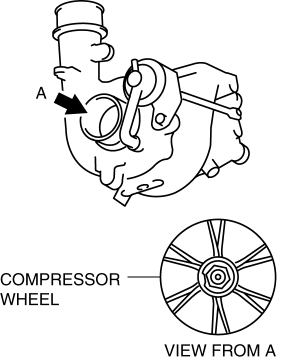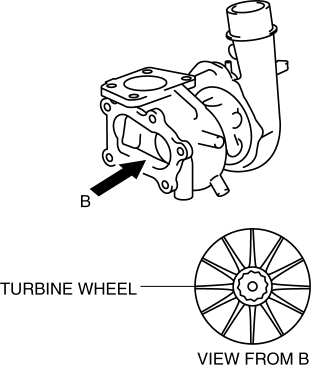Mazda 3 Service Manual: Turbocharger Inspection [Mzr 2.3 Disi Turbo]
Compressor Wheel Inspection
1. Remove the turbocharger..
2. Visually inspect the compressor wheel from view A for the cracks, damage, or bending on all the compressor wheel blades.

-
If there are any cracks or damage, replace the turbocharger..
NOTE:
-
If there is contact between the compressor wheel and compressor housing, there may be cracks, damage, or bending on the blade end area.
-
If there are cracks, damage, or bending on the compressor wheel, verify the following after replacing the turbocharger.
-
Intake air/exhaust system related components
-
Oil outlet pipe and oil inlet pipe damage
-
Turbine Wheel Inspection
1. Remove the turbocharger..
2. Visually inspect the turbine wheel from view B for the cracks, damage, or bending on all the turbine wheel blades.

-
If there are cracks, damage, or bending on the turbine wheel, replace the turbocharger..
NOTE:
-
If there is contact between the turbine wheel and turbine housing, there may be cracks, damage, or bending on the blade end area.
-
If there are cracks, damage, or bending on the turbine wheel, verify the following after replacing the turbocharger.
-
Intake air/exhaust system related components
-
Oil outlet pipe and oil inlet pipe damage
-
 Input/Turbine Speed Sensor Removal/Installation [FS5 A EL]
Input/Turbine Speed Sensor Removal/Installation [FS5 A EL]
CAUTION:
Always use a new bolt. If the removed input/turbine speed sensor installation
bolt is reused, it may cause oil leakage.
A sealant coating is applied to the input/turbine s ...
 Wastegate Actuator Inspection [Mzr 2.3 Disi Turbo]
Wastegate Actuator Inspection [Mzr 2.3 Disi Turbo]
1. Remove the air hose and air duct..
2. Disconnect the hose from the wastegate actuator.
3. Plug the wastegate actuator as shown in the figure.
4. Connect the vacuum pump to the port
5. R ...
Other materials:
General Procedures (Suspension)
Wheel and Tire Installation
1. When installing the wheels and tires, tighten the wheel nuts in a criss-cross
pattern to the following tightening torque.
Tightening torque
88—118 N·m {9.0—12 kgf·m, 65—87 ft·lbf}
Suspension Links Removal/Installation
1. For the joint sections ...
Liftgate Opener Switch Inspection
1. Disconnect the negative battery cable..
2. Remove the following parts:
a. Liftgate upper trim.
b. Liftgate side trim.
c. Liftgate lower trim.
d. Liftgate latch and lock actuator.
e. Liftgate opener switch.
3. Verify the continuity of liftgate opener switch terminals A and B.
4 ...
Theft Deterrent System Reading Freeze Frame Data
1. Connect the M-MDS (IDS) to the DLC–2.
2. After the vehicle is identified, select the following items from the initialization
screen of the IDS.
Select “Body”.
Select "Burglar Service Functions".
3. Then, select the following item from the screen menu.
...
